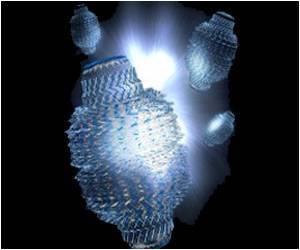A new nanoparticle that acts like a secret double agent has been discovered by scientists.

The paper will be published Jan. 21 in the journal Proceedings of the National Academy of Sciences.
"This has the potential to eventually become a nontoxic treatment for B-cell lymphoma which does not involve chemotherapy," said Gordon, a co-corresponding author with Thaxton on the paper. "It's an exciting preliminary finding."
Gordon is a professor of medicine in hematology/oncology and Thaxton is an assistant professor of urology, both at Northwestern University Feinberg School of Medicine.
Gordon also is co-director of the hematologic malignancy program at the Robert H. Lurie Comprehensive Cancer Center of Northwestern University and a physician at Northwestern Memorial Hospital. Thaxton is also a member of the Lurie Cancer Center.
Lymphoma Gobbles HDL Cholesterol
Advertisement
The nanoparticle -- originally developed by Thaxton as a possible therapy for heart disease -- closely mimics the size, shape and surface chemistry of natural HDL particles. But it has one key difference: a five nanometer gold particle at its core. Thus, when the nanoparticle is incubated with human B-cell lymphoma cells or used to treat a mouse with the human tumor, it socks lymphoma with a double whammy. After it attaches to the lymphoma cell, the gold particle's spongy surface sucks out its cholesterol while the gold core prevents the cell from absorbing more cholesterol typically carried in the core of natural HDL particles.
Advertisement
"At first I was heavily focused on developing nanoparticles that could remove cholesterol from cells, especially those involved in heart disease," Thaxton said. "The lymphoma work has broadened this focus to how the HDL nanoparticles impact both the removal and uptake of cholesterol by cells. We discovered the particles are multi-taskers."
The Northwestern study also showed that natural HDL did not kill the cells or inhibit tumor growth. The nanoparticle was essential to starve the lymphoma cell.
Detour From Heart Disease to Cancer Killer
After developing the HDL nanoparticle, Thaxton gave a lecture in 2010 to Feinberg faculty. Gordon was in the audience. He knew that patients with advanced forms of B-cell lymphoma sometimes have dropping levels of cholesterol. A long-time lymphoma researcher and oncologist, Gordon was looking for new methods to deliver drugs to patients. He contacted Thaxton and they began to collaborate.
They tested the HDL nanoparticle alone and the HDL nanoparticle transporting cancer drugs. Surprisingly, the nanoparticle without drugs was just as effective at killing the B-cell lymphoma cells.
"We thought, 'That's odd. Why don't we need the drug?'" Gordon recalled.
That's when the scientists began delving into the mechanism by which the HDL nanoparticles were sticking to the HDL receptors on the lymphoma cell and manipulating cholesterol transport. In addition, patient samples analyzed by collaborators at Duke University for the study showed that lymphoma cells in patients had an overproduction of these HDL receptors compared to normal lymphocytes.
B-cell Lymphoma Most Common Lymphoma
The National Cancer Institutes reports that in 2012 there were about 70,000 new cases of non-Hodgkin lymphoma in the U.S. with nearly 19,000 deaths. About 90 percent of those new cases were B-cell lymphoma. Non-Hodgkin lymphoma is a cancer that starts in cells called lymphocytes, which are part of the body's immune system.
Why a Heart of Gold?
"Gold has a good track record of being compatible with biologic systems," Thaxton said.
Thaxton and Gordon are encouraged by their early data showing that the HDL nanoparticles do not appear toxic to other human cells normally targeted by HDLs, normal human lymphocytes or to mice. Also, because gold nanoparticles can be made in a discreet size and shape, they are excellent scaffolds for creating synthetic HDLs that closely mimic those found in nature.
"Like every new drug candidate, the HDL nanoparticle will need to undergo further testing," Thaxton noted.
Source-Eurekalert












